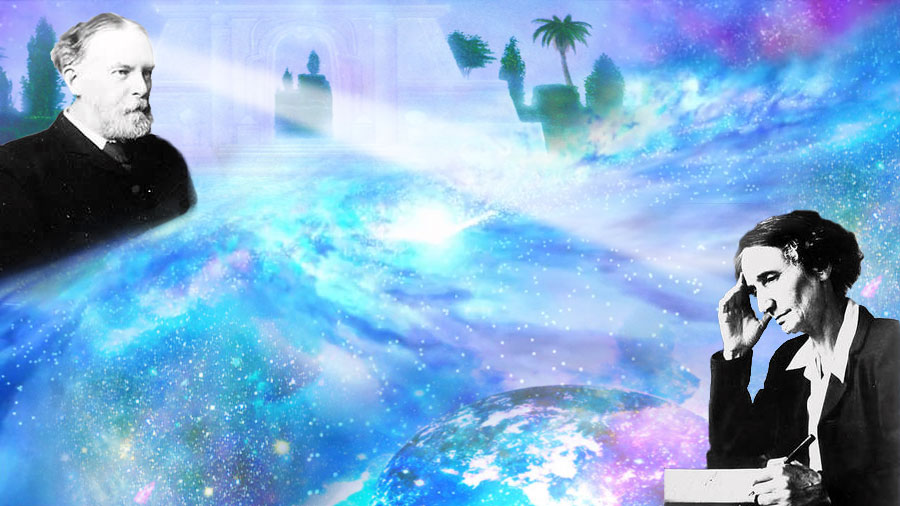A Communique From The Other Side
 by Stafford Betty
by Stafford Betty
The medium Geraldine Cummins was an Irish woman who authored 22 books, 15 of them automatically while in a light trance. She described her method in this way:
I am a mere listener, and through my stillness and passivity I lend my aid to the stranger [spirit] who is speaking. It is hard to put such a psychological condition into words. I have the consciousness that my brain is being used by a stranger all the time. It is just as if an endless telegram is being tapped out on it. The great speed of the writing suggests actual dictation, as though some already prepared essay were being read out to my brain.
E. B. Gibbes, a member of the Society for Psychical Research who sat beside her and assisted her for years as she channeled many different personalities, vouched that Cummins wrote in 50 different personalities, vouched that Cummins wrote in 50 different handwritings, none her own, each belonging to a different spirit. Often she produced the psychological idiosyncrasies of characters she had never met but were verified as authentic by those attending the séance. She wrote at tremendous speed, very unlike her sluggish pace when writing consciously. She was one of the most gifted mediums of the twentieth century.
The spirit communicator, Frederic Myers, was trained in the classics, lectured for a time at Trinity College Cambridge, wrote some very fine poetry, and spent the last thirty years of his life as a school inspector and advocate of women’s higher education. But it was during that last period, after meeting Stainton Moses in 1874, that his life’s true vocation surfaced. He would become to psychical research what Freud was to psychotherapy. One of the co-founders of the Society for Psychical Research in 1882, his influence on the young movement was immense. His monumental book Human Personality and Its Survival of Bodily Death is still regarded by many as the greatest work on psychical research ever to appear.
More to the point for our purpose, he was one of the spirits that came through Cummins. He first spoke through her in 1924, 23 years after his death, and reappeared intermittently until 1931. (He also communicated through other mediums from time to time.) The book we’ll be examining here, The Road to Immortality, is the record of their collaboration. It combines very fine writing with a rare breadth of vision.
Before looking at the world that emerges here, it’s worth noting that the spirit claiming to be Myers expresses impatience with the English language as well as with mediums who sometimes find it hard to blank out their own minds’ contents. Much about the world he tries to describe, especially the last three of the seven planes, can only be approximated by our language. It is with a feeling of awe, even unworthiness, that I try to summarize his account of these realms. In places the language becomes fuzzy, virtually unintelligible, so far beyond the world we are familiar with is his subject. One can imagine his impatience!
But he does manage to get across with clarity what it feels like, from his side, to work through a medium as gifted as Cummins. Here is what he said, writing through her hand, early in their partnership:
The inner mind [of the medium] is very difficult to deal with from this side. We impress it with our message. We never impress the brain of the medium directly. That is out of the question. But the inner mind receives our message and sends it on to the brain. The brain is a mere mechanism.
… In other words, we send the thoughts and the words usually in which they must be framed, but the actual letters or spelling of the words are drawn from the medium’s memory. Sometimes we only send the thoughts and the medium’s unconscious mind clothes them in words.
Myers makes it clear that he is far from infallible, even though he’s been in the spirit world longer than most communicators and has some experience of higher planes. But even at his level there is much that is mysterious, and spirits sometimes disagree with each other, he tells us, just as we do on earth.
He begins by announcing that there are seven planes that the spirits journey through, the first being a physical planet like our earth. It is followed by
(2) Hades or the intermediate State.
(3) The Plane of Illusion.
(4) The Plane of Color.
(5) The Plane of Flame.
(6) The Plane of Light.
(7) Out Yonder, Timelessness.
Myers has little to say about Hades, that place situated “on the frontiers of two lives, on the borders of two worlds.” For him it was a resting place, a kind of hospice where he recovered his strength and prepared himself for entry into the great world beyond. “Pray do not conjure up unpleasant associations with Hades,” he tells us. “I died in Italy, a land I loved, and I was very weary at the time of my passing. For me Hades was a place of rest, a place of half-lights and drowsy peace.”
Myers doesn’t tell us what happened to him next, but it’s clear he spent most of his time in the third and fourth planes. We’ll examine each in turn.
Myers uses the term Summerland for the Third Plane, but more often called it the ‘Plane of Illusion’. He also called it the ‘Memory-world’. Each of these terms brings out an important aspect of the Third Plane. Myers leads us into this world with these opening remarks: When people die,
They hunger for the dream which was home to them … they enter into a dream that, in its main particulars, resembles the earth. But now this dream is memory and, for a time, they live within it. All those activities that made up their previous life are re-enacted, that is, if such is their will … the soul, freed from the limitations of the flesh, has far greater mental powers, and can adapt the memory-world to his taste. He does so unconsciously, instinctively choosing the old pleasures, but closing the door to the old pains. He lives for a while in this beatific, infantile state. But, like the baby, he inhabits only a dream, and has no knowledge and hardly any perception of the greater life in which he is now planted.
Myers does not mean it is a literal dream, or a subjective illusion like a mirage, but only that it is a distraction or diversion from important business, and that it “fades before spiritual knowledge.” In fact Myers likens it to “the fundamental unreality of earth,” which of course, as we know, is real enough for us. A more helpful metaphor might be Disneyland. Disneyland is a real place, but it is also a place of pleasant, idealized make-believe, certainly not a part of the natural world. In the same way, the Third Plane that will greet us when we die will have been constructed by spirit architects who have the wisdom to know what we need at our present stage and the power to construct it.
Myers invents a typical character named Tom Jones to make his point. Jones, an ordinary lawyer’s clerk living in London all his life, has now just died and finds himself
born into the next world with all his limitations, with all his narrowness of outlook, with his affections and his dislikes. … He bears within him the capacity for recalling the whole of his earth life. Familiar surroundings are his desperate need. He does not want a jeweled city, or some monstrous vision of infinity. He craves only for the homely landscape he used to know. He will not find it here in the concrete sense, but he will find, if he so desires, the illusion … It undoubtedly presents a more attractive appearance than his little gray London world, but in essentials it is of the same familiar stuff from which his England is made.
He will also “find his friends, some of his own people, and those two or three persons he really loved; that is, if they have already gone before him, been summoned by death at an earlier time.” He tells us, “Nearly every soul lives for a time in the state of illusion.”
For most of us the Third Plane will be pleasant and familiar. Tom Jones’s environment won’t look much like a typical Eskimo’s, but will be free of suffering. There are exceptions, however. For example,
The cruel man who has changed his natural craving for affection into a longing to give pain to others necessarily finds himself in a world here where he cannot satisfy this craving. … In the new life [following death] he has not, for a time at any rate, the power to inflict pain on anything living. This means for him, with his greatly increased mental powers, a very terrible distress. … The misery of such an unsatisfied state is largely of a mental character. What use to him is a world of light and beauty while still this foul earth longing is unsatisfied?
Myers uses another example to show the great variety of experience in this ‘Illusion Land’. He asks us to consider the plight of a man who chased women and lived for sex. He finds,
when he enters the Kingdom of the Mind, that as his mental perceptions are sharpened so his predominant earth-desire is intensified, his mental power being far more considerable. He can, at will, summon to himself those who will gratify this over-developed side of his nature. Others of his kind gravitate to him. And for a time these beings live in a sex paradise. … They yearn still for gross sensation, not for that finer life, which is the spirit of sexual love, that perfect comradeship without the gratification of the grosser feelings. They obtain it in abundance, and there follows a horrible satiety. They come to loathe what they can obtain in excess and with ease; and then they find it extraordinarily difficult to escape from those who share these pleasures with them.
But eventually they will escape – Tom Jones from his unchallenging London-look-alike world, and the sex partners from each other. But what then? Where do they go next? It all depends, says Myers. It depends on how spiritually evolved they are. Broadly speaking, every human being falls under one of three headings. He or she is either “Spirit-man, Soul-man, or Animal-man.” The Animal-man, probably a majority of the human race during any time period, lives for pleasure. He doesn’t care of the joys of the intellect or the fine arts. He doesn’t read good literature. His appetites are exclusively physical and, as Myers puts it, “paltry.” There is no danger he will have gotten this far in our book. He is probably not cruel or corrupt; he might be sweet and generous. But his mind and spirit are still slumbering. And when he grows tired of the unchallenging look-alike world of the Third Plane, he desires change:
Usually, at this point, when longing for a new life with all his being, he desires that it shall be one with the flesh, that it shall be another episode passed in the grosser bodily forms. So he goes downwards; but he descends in order to rise. … During his next incarnation he will probably either enter into the state of the Soul-man, or he will at lest be less of an animal, and will seek an existence and follow a life of a higher order than the one he led when previously lodged in the flesh.
On the other hand, “I am told that the Animal-man occasionally prefers to enter a material existence on some other planet in which matter may be even denser than any earthly substance.”
But the Soul-man, as opposed to the Animal-man, when finally bored of the Third Plane, will embark on a very different kind of experience. He or she is now “an intelligent, ethically developed soul” and will elect to go upward to the next level, the Fourth, not downward for a repeat performance on a dense planet.
On the Third level, where familiarity and comfort had the highest priority, one’s ‘astral’ body was usually a replica of one’s earth body. Not on the Fourth. Here the Soul-man dons a ‘subtle body,”
a body entirely dissimilar from the human body. As regards appearance, it can only be described as being apparently a compound of light and colors unimaginable. The shape of this form is influenced by all the ego’s past acts so far as they have impressed themselves on his deeper consciousness. This colored compound may be grotesque, bizarre in form, may be lovely beyond words, may possess strange absurdities of outline, or may transcend the loftiest dream of earthly beauty. … It is far more fluidic, less apparently solid than earth surroundings.
And the outer environment of the Fourth Plane is compatible with his body:
Within the subtle world of which I speak you will perceive a variety of forms which are not known on earth and therefore may not be expressed in words. Yet there is a certain similarity, a correspondence between the appearances on this luminiferous plane. Flowers are there; but these are in shapes unknown to you, exquisite in color, radiant with light. Such colors, such lights are not contained within any earthly octave, are expressed by us in thoughts and not in words. For, as I previously remarked, words are for us obsolete. However, the soul, in this plane of consciousness, must struggle and labor, know sorrow but not earth sorrow, know ecstasy but not earth ecstasy. The sorrow is of a spiritual character, the ecstasy is of a spiritual kind.
Unlike the pleasant, insouciant, ‘illusory’ Third Plane of relatively low vibration, this “many-colored world is nourished by light and life in a greater purity [and] vibrates at an unimaginable speed.” This higher vibration hides it from earth’s most sensitive instruments, but in spite of its invisibility there is nothing remotely illusory about it. The Soul-man’s sensitivity has also been stepped up. Everything is experienced more intensely with his super-ethereal body and his IQ of 500. However, this heightening of experience doesn’t lead only to heavenly bliss, but sometimes to intense suffering, as when one meets an old enemy. His hatred of you will hit “your body of light and color” like a withering blast; for “when you meet,” it will not be dimmed down by the sluggish earth brain you used to labor through. Myers puts it this way:
You will understand, therefore, that pain and pleasure, joy and despair are once more experienced. Again, however, they differ greatly from the earthly conception of them; they are of a finer quality, of an intellectualized character. Mightier is their inspiration, more profound the despair they arouse, inconceivable the bliss they stir within the deeps of your being.
On this luminiferous plane the struggle increases in intensity, the efforts expended are beyond the measure of earthly experience. But the results of such labor, of such intellectualized and spiritualized toil and battle also transcend the most superb emotion in the life of man. In brief, all experience is refined, heightened, intensified, and the actual zest of living is increased immeasurably.
Myers goes on to say that on the Fourth Plane “the soul wears several bodies, passing from one to another as he advances” and that the “thought processes of the emotional life seem limitless when compared with the sluggish movements of the human brain.” Sublime exaltation, titanic struggle, acute suffering, indescribable bliss, and a thrilling sense of no-nonsense realness – all this and much more will comprise the future of those of us who resist the allure of another incarnation on earth. So reports Frederic Myers from the Other Side.
Before passing on to a description of the remaining three planes, Myers introduces us to the Group Soul, one of the hallmarks of the Fourth Plane. A Group Soul is “a number of souls all bound together by one spirit.” There are countless Group Souls, each headed and inspired by a single spirit of uncommon power. Each Group Soul might contain as few as 20 souls or as many as a thousand. And there is some unifying interest, for example music, that acts as the thread that binds the group together. Not all groups, however, are conducive to the growth of the souls that make it up. Although every soul is free, “a fanatical Buddhist or a very devout Christian may be held within the groove of his earthly beliefs” as if “held in chains,” and “such conditions tend to inhibit progress.” But most Group Souls significantly quicken progress. Myers is himself a member of one: “The interesting feature of my state here is that I am within a larger mind, and many of my affinities are contained in it.” He tells us we will “realize how fine and beautiful is this brotherhood within the one being; how it deepens and intensifies existence; how it destroys the cold selfishness so necessary to an earth life.”
Of special interest is the economy of the Group Soul. Each soul is so privy to the experiences of its fellows that the lessons normally learned only by a succession of many reincarnations can be speeded up. It works like this:
… what the Buddhists would call the karma I had brought with me from a previous life is, very frequently, not that of my life, but of the life of the soul [in my group] that preceded me by many years on earth and left for me a pattern which made my life. I, too, wove a pattern for another of my group during my earthly career. We are all of us distinct, though we are influenced by others of our community on the various planes of being.
Myers tells us he will not reincarnate. The surrogate experiences of his brothers and sisters, which he feels with as much intensity as if he were the actor, are teaching him all the remaining lessons of earth needed for his advancement.
That brings us to the Fifth Plane, the so-called Plane of Flame. Myers does not dwell at this level, so his description comes across as second-hand and vague. Added to that, this plane “may be imagined but not understood or conceived by a man’s mind.” We are in rarified air here. Myers tells us that an inhabitant here “remains himself, yet is all those other selves [in his group] as well. He no longer dwells in form – as it is conceived by man – but he dwells still in what might be described as an ‘outline’ … an outline of emotional thought: a great fire which stirs and moves this mighty being. Such a being “is continuously conscious. … He tastes of Heaven and yet the revelation of the last mystery tarries, still awaits the completion of the design of which he is a part.”
The Sixth Plane is even more nebulous. The bodies of spirits at this level are formless white light, and “pure reason reigns supreme. Emotion and passion, as known to men are absent. White light represents the perfect equanimity of pure thought. Such equanimity becomes the possession of the souls who enter this rich kingdom of experience. … They are capable of living now … as the pure thought of their Creator. They have joined the Immortals.”
The Seventh Plane – which Myers refers to simply as “Out Yonder” – is the end game and no longer counts as a realm of creaturely experience. Without a body of any kind, you merge with the “Great Source” and reign “in the great calm of eternity. Yet you still exist as an individual [and] are wholly aware of the imagination of God. So you are aware of the whole history of earth from Alpha to Omega. Equally all planetary existence is yours. Everything created is contained within that imagination, and you … know it and hold it. An eon of spiritual evolution is usually required before taking this step: “Only very few pass out Yonder during the life of the earth. A certain number of souls attain to the sixth state, but remain in it or, in exceptional cases for a lofty purpose, descend again into matter. They are not strong enough to make the great leap into timelessness, they are not yet perfect.”
Myers’ vision of our place in this stupendous scheme of things is both humbling and exhilarating. We are such puny creatures, yet our potential is unlimited. Apparently the Great Source has ambitious plans for us! Anyone looking for an easy ride into Eternal life is in for a severe shock if Myers is correct.
What exactly is the Infinite’s plan for us? Myers states it early on:
The purpose of existence may be summed up in a phrase – the evolution of mind in matter that varies in degree and kind – so that mind develops through manifestation, and in an ever-expanding universe ever increases in power and gains thereby the true conception of reality. The myriad thoughts of God, those spirits which inform with life all material forms, are the lowest manifestation of God, and must learn to become God-like – to become an effective part of the Whole.
All this sounds impossibly lofty. How can such words mean much to us – to us who run on such low spiritual octane, us kindergartners? We feel a queasiness in our stomachs! Yet the last words that Myers leaves us with are as down-to-earth as you can get: “Happiness comes through effort; through a wise and controlled indulgence in the pleasures of the senses; through athletic activities for the perfecting of the body; through study for the development of the mind; and through toleration of a charitable outlook. The development of these leads to the cultivation of spirit.” He even recommends making a good salary. “A desire for money in moderation is a virtue, for it happens to be a desire to become a complete man, and, through such completion and its resultant content, to benefit others.”
And who can deny his rapport with the common man or woman with this down-home reference. “I have been changing, evolving, putting on, if you will, like the trees, a fresh coat of leaves, but unchanged within; so that my wife and my children will know me [when they die] though some of my earth memories be buried as the foliage underground when winter comes.”
In the final analysis, however, Myers’ account stands out for many of us as one of the most fertile after-death communications in the entire literature because of its soaring vision of what our future can hold. The stunted being that we are now will bear little likeness to the colossus we will become – if we are willing to work for it.
Excerpt from The Afterlife Unveiled
Posted in Life After Death, Life On The Other Side, Other Topicswith comments disabled.





